Many owners of household plots are primarily thinking about a beautiful and unique landscape design. To create bright garden compositions, use a wide variety of decorative plants, among which both blooming cultures and evergreen shrubs and trees can be used. Among the most popular and demanded decorative plants among the gardeners are Tui. This is an evergreen, a beautiful coniferous plant includes a large number of the most incredible species and varieties that differ in both the height and the form of the crown.
Thuja Western Globes is a bright and spectacular representative of this family, which is distinguished by a compact spherical crown and changing the colors of the cheese. Such a kind of evergreen Tui will become an excellent decoration of the site and perfectly fit into any landscape composition.
In this article, consider the features and description of the Tui of the Character Globes, we note the basic uses on the site of various species of this culture. We give the most important rules and nuances of agrotechnics of growing Tui Globa
Features and morphological description of the Tui Globa
Thuja Western Globes is one of the most beautiful representatives of this family of decorative plants. Gardeners and landscape designers all over the world use this compact and bright culture in landscaping and decorating the household plot, as well as in the creation of unique garden compositions. The Thuja Globes is valued for its decorativeness, unpretentiousness in care, longevity and indescribable aroma of fresh needles.
Thuja Globes is a bright and popular Tui Western variety. It is this kind of 5 in the way of the thuu, the greatest love of all gardeners of the world. The same applies to the Russian gardeners who choose Western to landslide their sites. Thuja Globes is a coniferous evergreen tree, which belongs to the family of cypress. This decorative variety of Tui Western is considered to be dwarf and has a ball shape of the crown.
The natural habitat of the Tui Western Globa is considered the territory of North America. On the territory of Europe and Russia, this decorative plant fell in 1536, but a long-term evergreen shrub was introduced into the garden-park culture only in 1874. Since then, the Thuja Globes is grown everywhere, even in room conditions, which makes this evergreen beauty by a versatile plant. Very often, many gardeners confuse this variety with juniper. This is due to the common features and features of the appearance of two decorative crops: they are similar to the conditions of cultivation, belong to one family, besides, there are similar needles without needles.
Description of the Tui Globa:
- Thuja of this variety is a bright representative of Tui Western and is considered a perennial evergreen, a coniferous plant with a high decorative value throughout the year.
- The root system of the globe is compact and is located in the upper soil layers. Due to the fact that the roots of the plant are not long, evergreen bush can be grown in containers.
- From the root system, direct shoots of flat shapes are departed, which evenly disagree in different directions. The branches at the Tui spheroid are very thick, cross. Young plants are covered with a reddish-brick bark, which, as the plant grows, becomes grayish brown. A more adult plant has a smooth bark becomes fibrous, cracks appear on it.
- The dimensions of the adult plant of the globe of the globe constitute only 1.5-2 meters, the width of the evergreen bush also grow up 1-1.5 meters. At the same time, this compact Tui Western variety differs extremely slow growth - for the year the plant grows only by 5 cm. By 10 years, the bump of the globosis can be 1 meter in height, and by 20 years - 1.5 meters. Above this mark, it can grow copies of the Tui of this variety, which are planted in the shade and are pulled out because of this.
- Equally growing shoots allow the plant to form a flat and correct ball-shaped crown, which practically does not need trimming. It is due to its small size, this plant belongs to dwarf and externally resembles a green ball.
- The shoots of the plant are densely covered with scales. Unlike other coniferous crops, the Tui Globes has no needles, and their scales are very soft to the touch. The scales have a little flat shape, while the legs are located very tightly to each other, which helps to create a rounded shape of Crown.
- Approximately once every 2-3 years, it is recommended to carry out a rejuvenating trimming of the thuu of this variety, as the shoots begin to grow loose and lose their decorativeness.
- The scales have a different color depending on the season: the spring flakes of a light green or almost lightweight shade, in the summer become rich in green, and in the fall and winter brownish with iridescent plaques.
- On the needles, the cones of a rounded shape of a brown shade ripen, which in diameter can reach 0.7-1 cm. In the fruits, the seeds of the Tui globe that can be used for reproduction.
- The Thuja Globa is considered a drought-keeping and a frost-resistant plant that can grow perfectly in any conditions. This type of evergreen coniferous plants perfectly tolerates Russian cold and harsh frosts.
- Culture is a long-liver, in one place can grow not one decade. There are copies of the Globa Tui, which has more than 200 years.
Thuja Globes in Landscape Design - Use Options
Thuja Globes is a decorative evergreen plant that decorates the site throughout the year. Today this plant is considered one of the most beloved and frequently used in landscape designers and gardeners in Europe. In Russia, in recent years, the Thuja Globo is also gaining popularity and becomes part of unique garden compositions. Consider the main uses of this type of Tui Western in the landscape.
- Thus globa due to low compact growth is often used to create low living elevations. This option is used in urban landscaping, especially near restaurants or beauty salons, where the seedlings of the Tui of this variety are planted along the showcases or wallow the summer veranda.
- This type of thuu is used to create original garden compositions in combination with other types of coniferous crops. This plant can also be planted with deciduous decorative shrubs and other long-term cultures.
- Beautifully Thuja Globes looks in single landings, especially if the seedling is planted against the background of a green lawn.
- You can use this low-end for the framing of garden tracks or borders.
- The type of compact globe of the compact globe can be planted into containers or vases and decorate them arbors, terraces, balconies. Also, this plant can be planted for alpine slides and mixtures, it looks perfectly in stony gardens.
Characteristics of popular varieties of Tui Globa
Thuja Globes is one of the most popular varieties of Western species of this coniferous plant. She, in turn, also boasts bright forms that differ in both the height and the form of the crown. Consider two main varieties of the Tui Globa: Compact or Nana and Aurea.
- Thuja Globa Aurea. It is an evergreen, a coniferous plant, which is characterized by slow growth and long-life. In some cases, it can have a more elongated shape, ovoid. To the height of the bush can reach about 1-1.5 meters, in the diameter, the plant can also grow approximately 1.5 meters. The main decoration of the Tui Globa Aurea is considered to be its beautiful and spectacular needle of a lemon and green shade. In winter, the needle changes its color to brown-brown. The compact form of the crown is formed dense and flat shoots. The young needle has a very pleasant and useful odor due to the fact that the plant allocates phytoncides.
- Thuja Globes Compact or Nana. This type of the Tui Globa is very popular among the gardeners, as it has a compact crown and low growth. It is a beautiful perennial, coniferous plant, which in height can achieve the maximum as possible. Due to such growth, this species can be grown in vases or in containers. The diameter of the adult plant can be 1 meter. Crown is dense and very thick. The needles of a green yellow shade. The Thuja Compact Globes is good sustainable cold and drought.
Globes Tui reproduction: the most common options
To grow a sharp Western globe on its plot, under the power of any gardener, which at least a bit disassembled in all stages of agrotechnics of growing perennial coniferous crops. First of all, to dilute in the garden in the garden a large number of instances of the Tui or to create a living fence, you need to buy a large number of seedlings or take advantage of the reproduction of existing adult bushes. Thus globos can be multiplied by several ways: seed reproduction and with the help of cuttings. Each option has its own characteristics and characteristics that need to be considered to be as a result of getting beautiful and healthy plants. Consider a Read more Process of breeding the Tui Globa in various ways.
Seed reproduction of the Tui Globa
- With this method of breeding, it is important to take into account that young plants derived from seeds can lose all maternal varieties. However, for the purposes of the experiment, you can try to grow seedlings of the Tui globe using seeds.
- First of all, each gardener needs to get high-quality planting material. Tui seeds spit in cones, which are completely ripening in approximately in September-October. It is possible to determine the ripening of seeds by external signs: flakes on the cones become darker and begin to reveal a little. In this case, it is important to have time to collect seeds before they fall to the ground. Some gardeners recommend taking several cones in front of the ripening of gauze or a chip.
- The seeds obtained must necessarily dry in a ventilated room or outdoors under a canopy.
- After the seeds are dried, they must immediately mix with wet and clean sand and put in the refrigerator for 2-3 months for stratification. Store the seeds of the Tui Globes should not be, as they very quickly lose their germination.
- Next, after stratification, the seeds are removed from the refrigerator, they moisturize the sand and wait until the seeds begin to slander.
- Prepare suitable containers and tanks and fill them with light, nutritious and fertile soil. It is advisable to use medium cynical soils. Containers are placed in greenhouses or greenhouses, you can put on the windowsill.
- Seedlings rose quite slowly, while it is important to care for them carefully.
- Seeders only dive for the second year on specially prepared beds. Here young plants are 2 or 3 years. For winter, such fragile seedlings are covered with spruce legs and sprinkled a little by humus. In the spring, the plants are important to priest.
- At a permanent place, the Sapiece of the Globa globe is planted only after 2 years.
- When choosing such a breeding method, it is important to remember that it is possible to get full-fledged young saplings of the Tui only after 4-6 years.
Global Globes Globe Reproduction
- This method of breeding is used much more often, as in the end allows you to get a large number of strong and healthy seedlings. In addition, young plants completely adopt all the decorative maternal signs.
- It is possible to multiply with a globe with cuttings at different times, from here there will be differences in the technique of rooting. It is possible to harvest and disembark cuttings from spring to mid-summer or late autumn.
- In the spring with strong and healthy shoots, it is necessary not to cut, but to rip the cuttings with a heel, which allows them to root better. The length of one cutter should be approximately 5-8 cm. Next, from each twig you need to remove all the flakes from its under-part.
- Gardeners are recommended for some time to put the planting material in the container with the rooting agent to speed up the rooting of the planting material.
- If the cuttings were harvested in the spring, then it is best to plant them in a warm prepared bed, which added pre-manure, squeezing ground and river sand. About a year later, the rooted seedlings transplant to the shovel for the crevice.
- When using autumn shutdown, it is also important to take into account some nuances. In this case, it is recommended to establish a zip-package for rooting.
- The package must be filled with a suitable soil mixture, which should consist of leaf land and pure river sand. One seedling requires 1 cup of mixture.
- Before pouring out the mixture into the package, it must be carried out in the oven or shed a solution of manganese.
- The soil in the package is slightly watered and rooted in it in it, after which the package is closed and suspended in the warm room.
- You can land cuttings and a potted pot filled with fertile soil. In this case, it is necessary to build greenhouse from the package.
- When new sprigs begin to appear on the cuttings, it means that the planting material was rooted and it can be planted for a permanent place or a bed for rearing.
Planting the Tui Globa - a phased description of the process
Plant and grow in your site an evergreen plant. Those globoz under the power of each gardener. For this, it is important to know all the stages of preparation and actually planting the plant in the open ground. Consider all the details of the preparatory work and landing of the Tui of this variety.
Stage 1. Selection and acquisition of Sapieves of the Globa Tui
- First of all, each gardener needs to take care of buying high-quality and healthy seedlings of this plant. The planting material can be grown on their own, but if there is no time to the manipulation data, then you can simply buy saplings.
- You can buy a fair globe in specialized garden shops or nurseries that are professionally engaged in breeding plants. In this case, you will definitely believe that the landing material of this type of evergreen Tui is purchased.
- Many gardeners recommend buying seedlings with a closed root system, as such plants are best forbidden and adapt to climatic conditions.
- In any case, before buying landing material, you must carefully examine each seedling. Its upper part must be without visible damage, signs of diseases, yellowed needles. Special attention is paid to the root system check. At seedlings with open roots, the roots should be white and elastic. In containers with soil seedlings should be clean and moistened.
- Do not buy landing material on natural markets, as there is a great risk of acquiring poor-quality seedlings.
Stage 2. Choosing a place to land the Tui Globa
- A further step will be the choice of an optimal place to land the Tui Globa.
- The plant of this variety prefers to grow in open sunny places, as the sunlight is needed for a saturated yellowish green shade.
- You can land seedlings in a light half, however, in this case, the needles can lose its decorativeness, and Krona become more loose.
- For planting this plant, it is important to choose a place protected from strong wind and drafts.
- The Thuja Globes does not endure the conjunction, therefore, on your site, groundwater is lowered higher than 1.5 meters, then an artificial holloch or elevation is recommended.
- When choosing a landing room, be sure to focus on the alleged garden design. In addition to the plot, seedlings can be planted and spacious vases and garden pots.
Stage 3. Choice and soil preparation for landing the Globa Tui
- It is especially important for the successful landing and cultivation of the globa of the globe to choose the optimal composition of the soil.
- It is important to remember that the soil for this plant should be drained.
- Thuja can grow on any soils, but the light, loose soils are ideal for this evergreen culture. It is advisable to use peat soils, dry or clay.
- The plant prefers the weakly acidic soil reaction.
- Before the landing, it is desirable to carefully prepare the selected area. For this, it is cleared of weeds and is drunk at about 1 bayonet shovel, after which it is frozen and levels.
Stage 4. The process of landing Tui Globa
- Planting the Tui of this species into the open ground is carried out in the spring after the threat of return freezers, or at the end of August - early September. However, in the middle lane of Russia, it is preferable to use a spring landing so that the seedlings do get tight.
- First of all, it is necessary to prepare the landing place and landing pit for planting. The depth of the pit should be more root system along with an earthen room. Approximately the parameters must be as follows: 50-60 cm in width and as much in depth. If you are going to land the saplings of the Tui of this variety as a living hedge, then the distance between the plants should be 60-70 cm.
- At the bottom of each landing jama, it is necessary to pour a layer of drainage, since this plant does not endure moisture in the roots. As a drainage, clamzit, fine gravel or broken brick can be used. The drainage layer must be 15-20 cm.
- Next, the unscrewed layer of the soil must be mixed with humid and mineral fertilizers. It is also necessary to take care of a suitable soil composition. It is advisable to prepare a mixture of the turf, sand and peat.
- Seedlings in containers need to be plentiful to water to facilitate further extraction. If you bought seedlings with an open root system, be sure to check the condition of the roots.
- At the top of the drainage layer, push the small hilly of the nutrient soil mixture and put the seedling together with the earthen room.
- Carefully pour plants, gradually sealing soil.
- After landing, use every plant abundantly and climb the rolling circle to peat or humus.
Agrotechnical cultivation of the Globa Tui: Secrets and Nuances of Care
Care of the Thuy Globes is not distinguished by complexity, it suffices to comply with the important conditions for cultivation of culture and to devote their attention to the coniferous plant.
- Watering. Immediately after landing for a whole month, watering the Globa Tui is necessary once a week, pouring one bucket of water. In the future, it is necessary to water regularly, but moderately. In a particularly dry period, two irrigation is required per week at the rate of 1.5-2 buckets per plant. Loves Thuja Globes and Spring Crown. Making this procedure is recommended in the morning and in the evening. At the same time, it is necessary to observe the measure, since excessive moisture on the needle can lead to diseases.
- Loosening and mulching. Regularly the soil around the plants should be loosened and remove all weeds. To reduce the amount of irrigation and prevent excessive evaporation of moisture, you need to constantly change the layer of mulch. In this case, a peat or pieces of bark are used.
- Feeding Thuja Globa in the first three years after landing does not need additional feeding. In the future, fertilizers can be added twice the season. You can use humid or ready-made complex mineral fertilizers.
- Protecting the Tui Globa. Pruning this plant must be carried out each spring to remove damaged and broken branches. When forming the crown, it is necessary to cut down the shoots maximize by 1/3 of the part. Once every 2-3 years, it is recommended to carry out a rejuvenating trimming, during which the shoots are shortened almost half.
- Shelter in winter. Before the onset of cold weather, you need to emphasize the shoots to tie into the case of a snowy winter, as the snow can break the branches. Next, many gardeners are recommended to cover the same globious material.
Thuja Globes - Photo
Thuja Globa is a bright representative of Tui Western, which has high decorativeness and is considered one of the most beautiful plants of this family. At its site, the spectacular bush of evergreen plants is simple enough, the main thing to comply with all the rules and adhere to the conditions required by the plant.

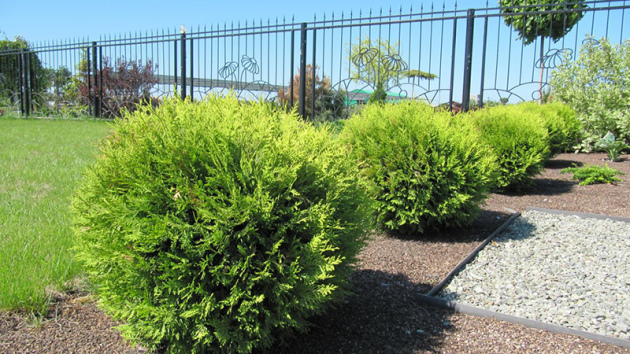
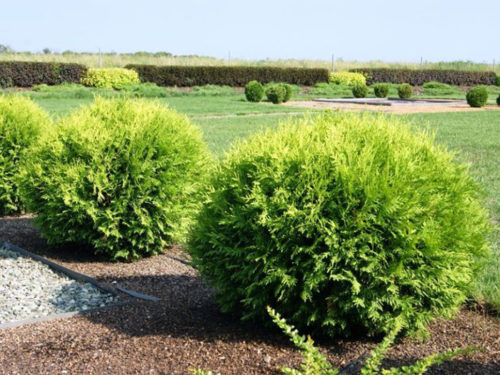
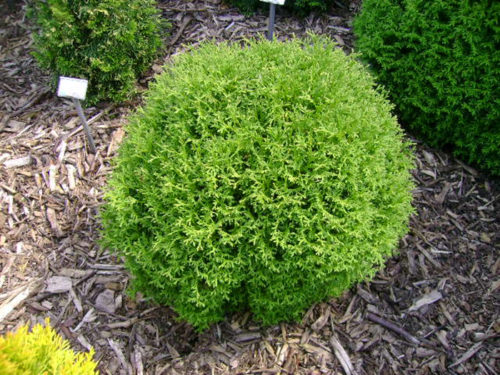

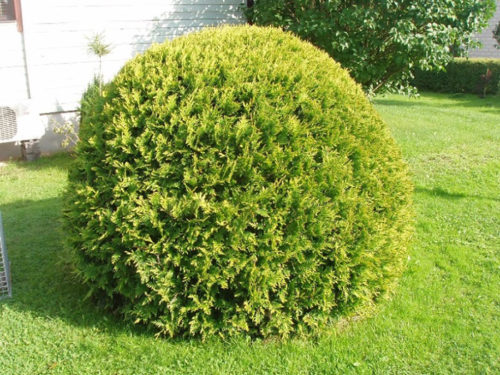
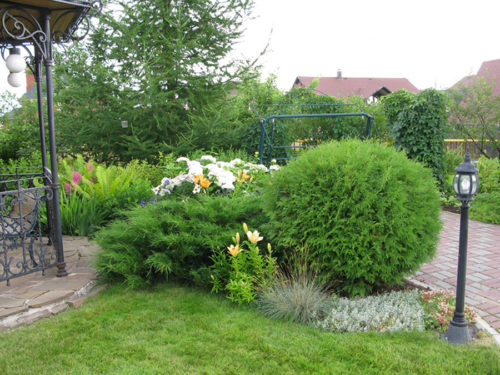
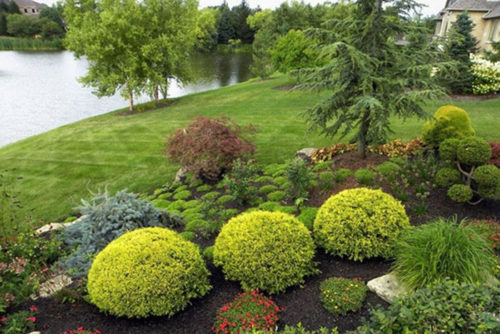
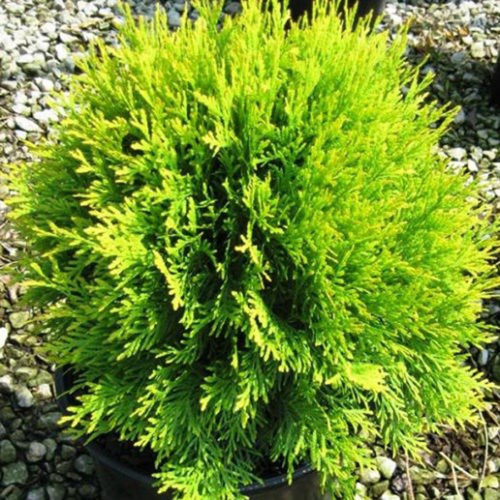
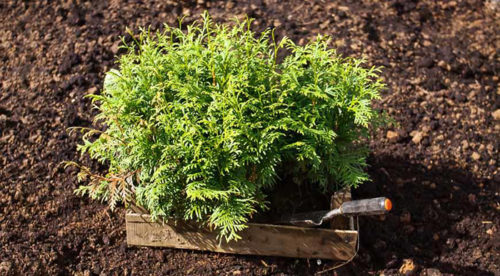
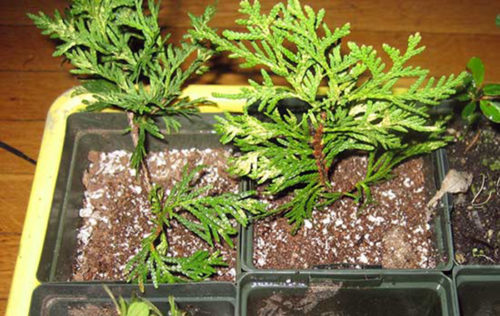
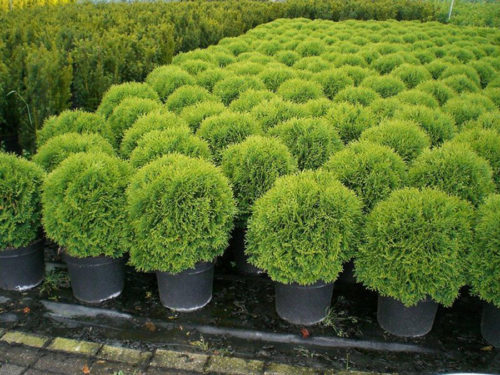

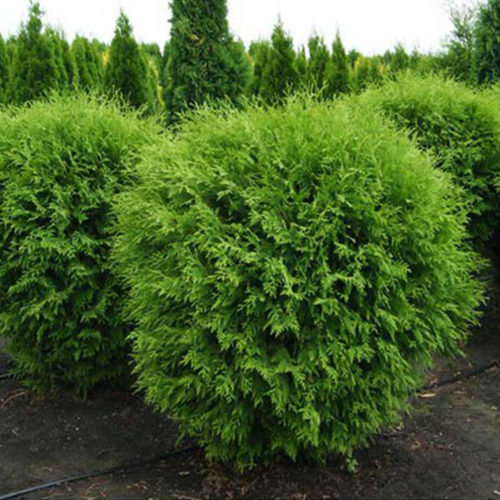
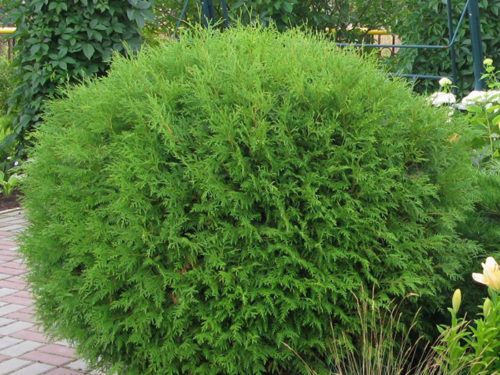
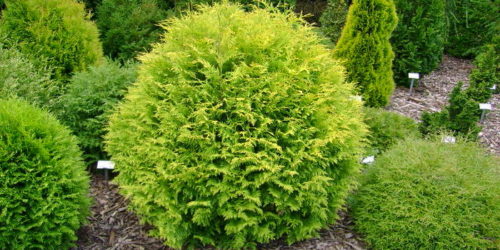
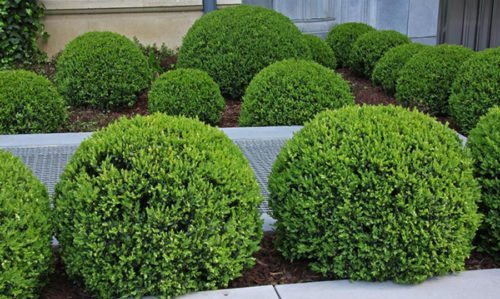
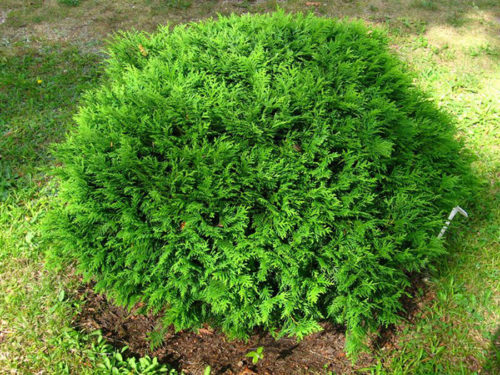












 Start a discussion ...
Start a discussion ...